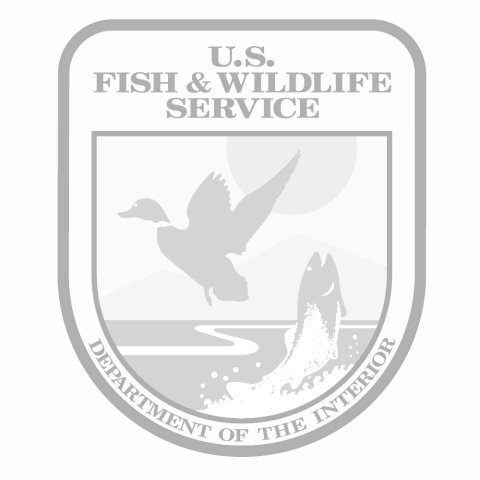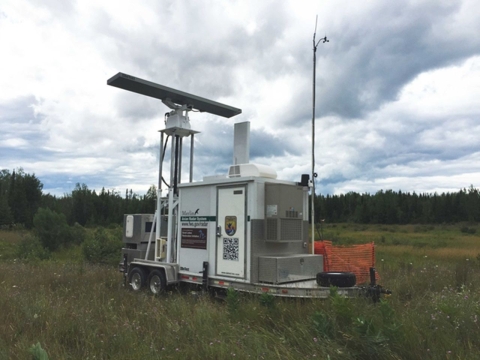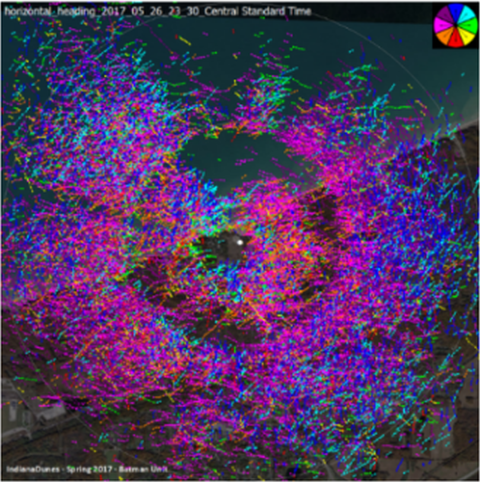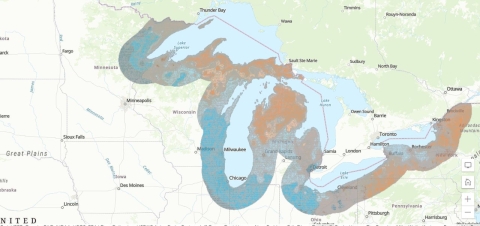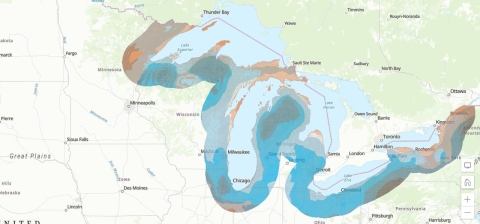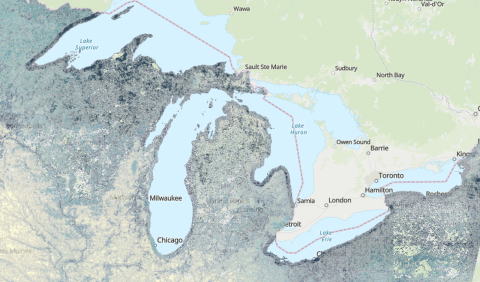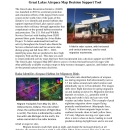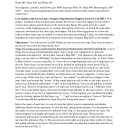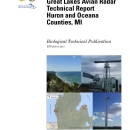Bird and bat concentration areas in the Great Lakes basin are mapped! These maps can help inform conservation and are found in the Great Lakes Airspace Map Decision Support Tool.
Every spring and fall, millions of birds and bats migrate through the Great Lakes region as they travel between their wintering and breeding grounds. The Great Lakes are a barrier for many species; for example, concentrating migratory birds along lakeshores, where they need to land each day to forage before continuing nighttime migration. By studying when, where, at what altitude, and under what conditions birds and bats migrate, the U.S. Fish and Wildlife Service (Service) developed a Decision Support Tool (DST) designed to provide conservation managers with information on important habitat on the ground (i.e. stopover habitat) and in the air (i.e. airspace habitat) and to help guide and prioritize locations that would most benefit avian migrants and migratory and non-migratory bats.
With funding provided by the Great Lakes Restoration Initiative(GLRI), the Service studied bird and bat activity using avian radar and acoustic bat monitors. GLRI was launched in 2010 to accelerate protection and restoration efforts of the largest fresh-water system in the world. One of the goals of this initiative is to identify and protect habitats that support important Great Lakes species and to increase their resiliency through approaches that complement on-the-ground habitat restoration and protection. The Service pursued these goals on behalf of migratory birds and bats through the GLRI-funded Avian Radar Project. We deployed radar units and acoustic monitors during spring and fall seasons from 2011 through 2018 across the Great Lakes to better understand bird and bat migratory behavior. These data were used to create predicted concentration maps that have been incorporated into the Great Lakes Airspace Map DST.
The Great Lakes Airspace Map DST allows users to overlay bird and bat activity maps with other publicly available data layers and project maps to help resource managers, agencies, project funders, developers and other stakeholders integrate migratory bird and bat considerations into their on-the-ground habitat protection, restoration planning, and decision-making.
The DST contains a number of bird and bat map-layers, details on these layers can be found within the DST. Bat layers are based on acoustic data and bird layers are based on avian radar data. Sufficient radar data were collected to allow a measure of variation, which accompanies maps that show concentration of use.
To learn more about the Great Lakes Airspace Map DST, check out this Story Map. To use the DST, sign up for ArcGIS Online first, then check out the DST here Great Lakes Airspace Map DST. You can find helpful tips and examples for using the DST in a user's guide, posted in the documents section below. Also check the documents section for project reports, a factsheet, and the full radar dataset for the Avian Radar Project. A project publication comparing migrant use of shoreline and inland areas can be found in Movement Ecology. If you have questions, please contact Jennifer White.
The Radar Team
Thank you to the talented Service employees who worked on the Avian Radar Project over the years; Tim Bowden, Jeff Gosse, Kevin Heist, Rebecca Horton, David Larson, Daniel Nolfi, Erik Olson, Nathan Rathbun, Elizabeth Rigby, Mike Wells, and Jennifer White.
Other Helpful Sites and Tools
- Upper Midwest/Great Lakes Joint Venture, Conservation Planning and the Great Lakes Stopover Map tool.
- Nature’s Network for conservation tools and resources around Lakes Erie, Ontario and the Northeast Region.
- U.S. EPA Great Lakes Restoration Initiative and U.S. Fish and Wildlife Service GLRI projects.
Frequently Asked Questions
- Can you identify migrants to species with this radar? No, it’s not possible to tell birds from bats, nor different species of nocturnally migrating birds. We can be confident we are monitoring primarily migrating birds because they have a pattern of spring and fall migration that is different from bats. We can identify rain by pattern and insects by slow flight, these are excluded from analyses.
- What is meant by airspace habitat? And, how does that relate to what we traditionally think of as habitat? We are used to thinking of habitat as a place where we typically see an animal, e.g. in trees, shrubs or on the ground. Habitat is defined as a place where an animal lives and meets its needs of finding food, shelter, a mate or breeding site. For migratory birds this includes land-based habitat for breeding, wintering, and sites between the two, known as stopover sites. In going between these sites birds fly long distances, and, using radar, we are learning what they need for a successful migration. Migrants need to move between the ground and different air layers freely, to find favorable winds and look for a landing site. Threats to safe migration include lack of quality stopover habitat, disorientation by artificial-light-at-night and collision with human made structures. We now know that we also must protect airspace habitat; for example, by instituting lights out programs in urban areas we can prevent birds being drawn off their migratory path and prevent mortality from collisions.
- Can I use this type of radar to study local bird or bat movements? These radar units are not reliable for studying movements at altitudes below 150 meters; local movements may be better studied with ground surveys, e.g., radio-telemetry, acoustic surveys, or thermal imaging cameras.
- What is the difference between these avian radar units and NEXRAD radar? NEXRAD, or Next Generation Weather Radar, is a system of weather radars at 160 fixed locations in the U. S. Biologists may use both types of radar to collect data about bird migration and stopover sites. One difference between the two types of radar is that avian radar units are mobile so can be moved to areas biologists would like to study, or to areas where NEXRAD cannot reach. Another difference is that avian radar units collect vertical data which provides an accurate count of migrants and their abundance at different altitudes. Additionally, avian radar units track individual targets, so it is possible to see variation in movement among individuals.
- Can these maps be used to time lights out programs for bird movements? These predictive maps were based on data collected over a 10-year time span. Timing of bird movements are difficult to predict and vary based on a number of factors, particularly weather factors including prevailing winds and storms. A safe solution to protect birds is to institute a voluntary lights out program during spring and fall migratory periods for communities within the Great Lakes basin and along its lakeshores. For example, Chicago’s Lights Out program turns lights off at 11:00 p.m. during spring (March 15-June 15) and fall (Aug 15-Nov 15) migration. Areas of high migrant passage rate have been mapped in the DST, which suggest these areas should be priority areas for Bird Safe programs.
Contact Information
